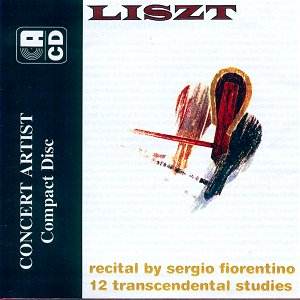I recently reviewed the latest release in APR’s Fiorentino
series, a finely controlled and deeply poetic Liszt recital to which
I would direct readers interested in this still contentious musician.
Concert Artist/Fidelio Recordings, who recorded much of Fiorentino in
the 1950s and 1960s and whose devotion to him was notable has now released
a sheaf of his recordings, newly remastered, some live, several from
newly discovered master tapes, many previously unissued, to increase
yet further ones knowledge and experience of the young pianist – he
was twenty seven when he set down this set of the awesome Transcendental
Etudes.
In fact going through the catalogues I haven’t been
able to discover an earlier complete set than this February 1955 traversal
– with the caveat that it was never issued at the time. The Etudes were
recorded the day after his London debut, at Wigmore Hall, and the masters
then sent to America where they were stored and subsequently believed
to be lost. I believe that a selection of them, Nos 3, 4, 5, 6, 10 and
11 was announced for issue, on Concert Artist CALP 1062, and is so listed
in a supplementary volume of The World’s Encyclopaedia of Recorded Music.
Many years later, in 1966 Fiorentino was recording for Concert Artist
in Guildford and warmed up with some of the Etudes – these performances
were recorded and some patching has been done using these performances
to cover the storage damage to the original tapes.
Enough of the background. These are deeply accomplished
performances and confirm the pianist, to my ears at least, as a master
Lisztian. I noted in my review of the APR disc some of the qualities
of his musicianship that I found so impressive; strong technique, textural
transparency, a superb and eloquent control of dynamic gradients, a
never forced-through tone, a lack of egocentricity – vital in Liszt
- faithfulness to the score without becoming in any sense literal minded,
aristocracy of phrasing, clarity and poetry existing as prerequisites
and a tone of great beauty. Here these qualities are equally audible.
In the A Minor Molto Vivace [No 2] he deals with those crashing martellato
episodes with sovereign skill, in Paysage there is true nobility
of phrasing, evocative and lyrical, with trademark dynamic control.
The way he builds up to the climaxes is estimable. Mazeppa, one
of a number of the pieces to have taken on independent life – recorded
individually too from the 1920s onwards – is another test of Fiorentino’s
mettle. The double note ascending run is tightly focused rhythmically
in his hands; whereas his soft and pliant phrasing never loses the arc
of the line, never loses sight of the architectural inter-relatedness
of things. The increasing technical demands bring some storming virtuosity
and an admixture of a much-undervalued Fiorentino quality, wit. His
conception is not as monumental or frank as, say, Egon Petri’s but survives
the comparison handsomely.
Feux follets is a measure of Fiorentino’s controlled
virtuosity; the left hand is animated and active but not over-scaled,
the tempo is certainly not the hell-for-leather scamper others routinely
make of it, dynamics are not of the vertiginous kind drawing attention
to the sudden withdrawal of tone, his chordal depth even. A contemporary
musician such as Kissin is much quicker and considerably more abrupt,
lavishing vigorous accents as he goes. Vision’s arpeggios are
powerful and virtuosic but not overnuanced; steady regret is harnessed
to relentless power. No bluster or gabble intrudes on Wilde Jagd;
instead clarity and definition without any loss of romantic impress
are Fiorentino’s birthright. This is certainly not playing of nonchalant
abandon, of paraded panache or preening, jaw-dropping technique, rather
it’s sensitivity allied to virtuosity and all the better for it. Some
might prefer Kissin’s rocket propelled attack or Berman’s legendary
traversal; but Fiorentino is a master of true musicianship and makes
many other pianists sound gauche and arid by comparison. The ruminative
cantilena of Ricordanza brings with it Fiorentino’s quasi-improvisatory
freedom and flexibility that serves only to intensify what Busoni famously
called "a bundle of faded love letters from a somewhat old fashioned
world of sentiment." In the Allegro agitato molto he never becomes
brittle or mechanical – but he does become passionately declamatory
and in Harmonies du soir, a landscape of touching beauty, he
is veiled, not too fast, with its central "sentimental" panel
properly related to the outer, both in terms of tempo and mood. How
many pianists fail to fuse the movement into a cohesive entity. The
final piece, Chasse-neige, a fitting and cataclysmically desolate
conclusion brings from Fiorentino an implacable and defining terror,
his left hand chromatic flurries dramatic without grotesquerie. Obviously
the recording can’t project the sheer terror as well as one could expect
today but there’s no doubting Fiorentino’s command of sonority, keyboard
and text.
The recording was made at quite a low level but has
been expertly remastered; examples of obvious edits, where the 1966
warm ups have been patched, are not noticeable. The documentation is
thorough; Humphrey Searle’s notes on the Etudes are reprinted, as is
biographical material on Fiorentino himself, who emerges, yet again,
as a musician of the highest nobility and stature.
Jonathan Woolf
MusicWeb
can offer the complete Concert
Artist catalogue


